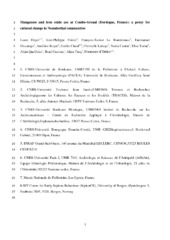| dc.contributor.author | Dayet, Laure | |
| dc.contributor.author | Faivre, Jean-Philippe | |
| dc.contributor.author | Le Bourdonnec, F.X. | |
| dc.contributor.author | Discamps, Emmanuel | |
| dc.contributor.author | Royer, Aurélien | |
| dc.contributor.author | Claud, Emilie | |
| dc.contributor.author | Lahaye, Christelle | |
| dc.contributor.author | cantin, Nadia | |
| dc.contributor.author | Tartar, Elise | |
| dc.contributor.author | Queffelec, Alain | |
| dc.contributor.author | Gravina, Brad | |
| dc.contributor.author | Turq, Alain | |
| dc.contributor.author | d'Errico, Francesco | |
| dc.date.accessioned | 2020-05-28T10:50:50Z | |
| dc.date.available | 2020-05-28T10:50:50Z | |
| dc.date.issued | 2019 | |
| dc.Published | Dayet L, Faivre J, Le Bourdonnec, Discamps E, Royer A, Claud E, Lahaye C, cantin, Tartar, Queffelec A, Gravina B, Turq A, d'Errico F. Manganese and iron oxide use at Combe-Grenal (Dordogne, France): A proxy for cultural change in Neanderthal communities. Journal of Archaeological Science: Reports. 2019;25:239-256 | eng |
| dc.identifier.issn | 2352-409X | |
| dc.identifier.issn | 2352-4103 | |
| dc.identifier.uri | https://hdl.handle.net/1956/22394 | |
| dc.description.abstract | Neanderthal material culture patterning in Western Europe has been primarily approached from retouched stone tools and associated flake production methods. While considerable effort has been devoted over the past decade to better characterize Middle Palaeolithic lithic techno-complexes (LTCs) in this region, the extent to which they reflect cultural groups still remains unclear. In this respect, integrating other forms of archaeological evidence could provide valuable insights on the cultural significance of late Middle Palaeolithic industrial variability. The site of Combe-Grenal (Dordogne, France) has yielded consistent evidence of mineral pigment use throughout the upper part of the sequence. Here we explore whether mineral pigments might be embedded with an indexical meaning and if changes in pigment exploitation potentially reflect cultural changes. We combined a microscopic use-wear approach with SEM-EDS, pXRF, and XRD analyses of 73 pigment fragments from layers 26 to 11 in order to reconstruct the different stages of their acquisition and use (provenance, selection, processing, function). Our results show manganese oxides to have been used in the lower layers of the Quina LTC, while red and/or yellow iron oxide pieces were employed during the Discoid and Discoid/Levallois LTCs. This decrease in manganese oxide use correlates with a change in lithic technology and may represent some form of cultural change. | en_US |
| dc.language.iso | eng | eng |
| dc.publisher | Elsevier | eng |
| dc.rights | Attribution-NonCommercial-NoDerivs CC BY-NC-ND | eng |
| dc.rights.uri | http://creativecommons.org/licenses/by-nc-nd/4.0/ | eng |
| dc.title | Manganese and iron oxide use at Combe-Grenal (Dordogne, France): A proxy for cultural change in Neanderthal communities | eng |
| dc.type | Peer reviewed | |
| dc.type | Journal article | |
| dc.date.updated | 2020-01-24T11:35:52Z | |
| dc.description.version | acceptedVersion | |
| dc.rights.holder | Copyright 2019 Elsevier | eng |
| dc.identifier.doi | https://doi.org/10.1016/j.jasrep.2019.03.027 | |
| dc.identifier.cristin | 1706773 | |
| dc.source.journal | Journal of Archaeological Science: Reports | |
| dc.source.pagenumber | 239-256 | |
| dc.relation.project | Norges forskningsråd: 262618 | |
| dc.identifier.citation | Journal of Archaeological Science: Reports. 2019;25:239-256 | |
| dc.source.volume | 25 | |

